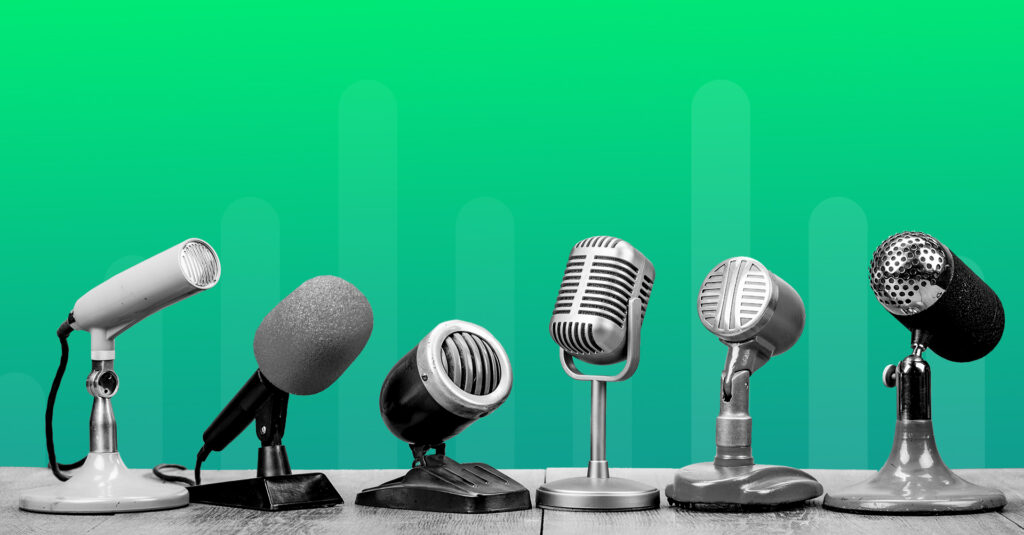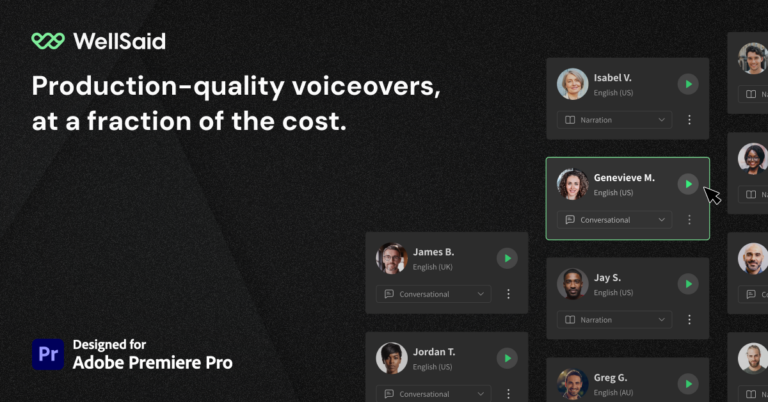Audio by Chase J. using WellSaid Labs
If the mere mention of “sonic identity” leaves you breaking into a cold sweat or scratching your head in bemusement, you’re not alone. For many a marketer or creative director, the concept of a brand’s audio persona sounds like a subplot in a science-fiction novel–a far-flung tech innovation dreamt up by Silicon Valley whiz kids.
Yet, if I were to mention “I’m lovin’ it,” or “Just do it,” you’d instantaneously hum the jingle or visualize the swoosh. So, what if I told you that the auditory equivalent of these visual identities, sonic identities, holds untapped potential to skyrocket your branding?
After all, have you ever stopped to consider why the intonation of Morgan Freeman’s voice elicits such a warm and soothing feeling? Or why the distinctive tone of Siri’s voice has become a household presence? Or, maybe even why all these years later people still recognize Yogi Bear’s voice? It’s because of the power of sound. And, more specifically, the magic of sonic identity.
Sonic identity, the auditory twin of visual branding, is no longer a distant galaxy in the marketing universe. It’s here, and it’s happening now.
What is sonic identity?
Sonic identity, or audio branding, is kinda like the audible DNA of your brand. Think of it as the voice behind your logo. A symphony of sounds ranging from jingles and voice overs to sound effects, all designed to create an emotional connection with your audience and foster brand recognition.
For the unacquainted, this might seem a tad nebulous. However, sonic identity is more than just a fancy buzzword. It’s a tool that amplifies your brand’s essence, mirroring its values, culture, and mission through the medium of sound. And much like a logo, its purpose is to resonate with your audience and etch your brand into their auditory memory.
Why does sonic identity matter?
Now, you might be wondering why all the noise about sonic branding? Here’s the deal: 40% of businesses have already tuned into the voice branding wavelength. While this statistic speaks to its growing popularity, it also highlights an opportunity for brands to stand out amid the cacophony of digital chatter.
Still, make no mistake, sonic identity isn’t about one-size-fits-all. Much like the diversity of your audience, using varied voice styles allows your brand to engage more personally with different demographics, ultimately driving conversion, engagement, and retention.
Examining sonic identity in branding
Still not convinced? Consider the universally recognized golden arches of McDonald’s. Now, imagine boosting that recognition. Interestingly, our reaction time to auditory stimuli is faster than our response to visual stimuli– .25 and .17 seconds, respectively. Therefore, sonic identity gets you closer to your audience faster than your brand’s visuals. Plus, considering the only sense to elicit a faster response is touch, it’s just about as close you can get to your audience without, you know, physically poking them.
This speedier connection has a profound impact too. Studies reveal that listeners can guess personality traits, socioeconomic status, and even physical attributes from a person’s voice with surprising accuracy. This means your audience will make inferences about your brand based on its sonic identity. The power is in your hands (or, perhaps more aptly, your voice).
Finally, it’s worth pointing out that the auditory revolution isn’t merely a fleeting trend. It’s a wave, spurred by the proliferation of video content and digital platforms. In a recent Spotify report, 63% of millennials and 65% of gen Z claimed audio to be the most immersive form of media.
Where will my brand’s sonic identity appear?
Here’s a big, but often overlooked, question–where will this sonic identity show up IRL? Content channels for marketers are more than plentiful. But to put it into perspective, here are a few popular spots we’ve seen.
Podcasts: With over a million podcasts out there and more cropping up each day, there’s no better way to infuse your brand’s voice than through this trending platform. An AI voice can create consistency, providing a familiar presence that listeners tune into week after week.
Ads: Imagine having the flexibility to tailor your brand’s voice to different campaigns without a hodgepodge of inconsistent tones. AI voices provide the flexibility to play with vocal range while maintaining your brand’s sonic identity.
Explainer and learning videos: Break away from monotonous robotic voices. Instead, use an AI voice that resonates with your audience and breathes life into your brand—turning ordinary explainer videos into memorable stories.
On-hold messages and IVR systems: Turn your customers’ waiting time into an auditory branding opportunity. Instead of frustratingly robotic voices, a friendly and engaging AI voice can enhance customer experience.
Public announcements: From in-store announcements to event promotions, make your brand’s sonic presence felt in every corner with a consistent AI voice.
Factors in fine tuning your sonic identity
When it comes to building a sonic identity, we’re not shooting in the dark here. It requires meticulous thought and planning. As such, here are key considerations to help you hit the bull’s eye.
Ladder up to your overall brand identity
Perhaps most importantly, your sonic identity should feel like a seamless extension of your brand, complementing your visual identity and brand message.
Know your audience
Your brand’s voice should echo the sentiments and preferences of your target demographic. For instance, a younger audience might appreciate a more upbeat and vibrant voice, while an older demographic might resonate with a calm and soothing tone. Research your audience, and let their preferences guide your choice of voice.
Brand perception
Your brand’s sonic identity should align with the image your audience has of your brand. Is your brand perceived as playful and energetic or serious and trustworthy? Your chosen voice should mirror these traits.
Resonating sounds
What types of sounds resonate with your customers? This could be influenced by their cultural background, age, or lifestyle. Deep dive into your customer’s preferences to strike the right chord.
Emotional range and impact
Do you want your voice to invoke laughter or convey authority? The emotional impact of your voice plays a crucial role in shaping your brand’s sonic identity. Consider the emotional range your brand wants to cover and match your voice accordingly.
Competitive analysis
What voices are your competitors using? A competitive analysis can help identify gaps in the market and assist you in creating a unique sonic identity.
Consistency across touchpoints
Whether it’s a podcast, commercial, or explainer video, maintaining a consistent voice across all touchpoints helps establish familiarity and builds trust with your audience. However, be mindful of overusing a voice, as it may become grating over time.
Creating a sonic identity is more art than science. It’s about finding the voice that not only speaks to your audience but also speaks for your brand. Remember, in the grand concert of branding, your sonic identity is the melody that lingers, long after the note has been played.
Concluding thoughts
So, what’s stopping you from exploring your brand’s sonic identity? At WellSaid Labs, we not only offer a diverse range of AI voices but also build custom voices tailored to your needs. Back in 2020, we reached human parity, and with a mean opinion score of 4.5, we outperform Google’s TTS at 4.1.
In a world where people skim read, why not let your brand be heard, not just seen? After all, the future of branding isn’t just visual. It’s sonic. 🔊




